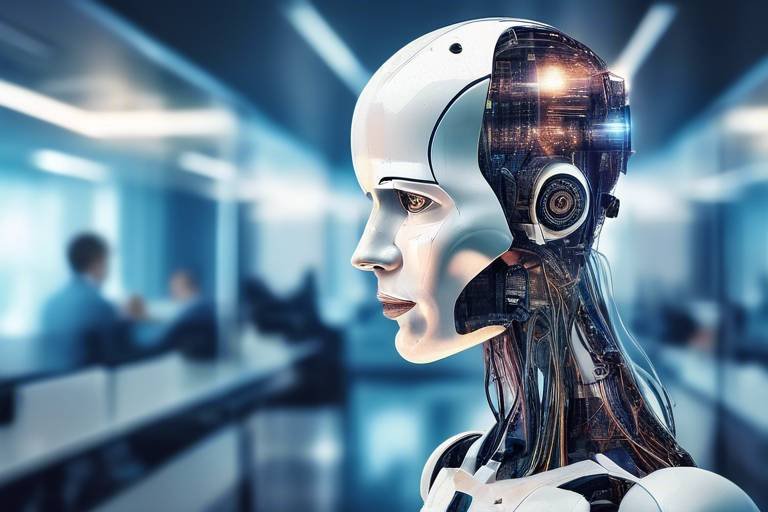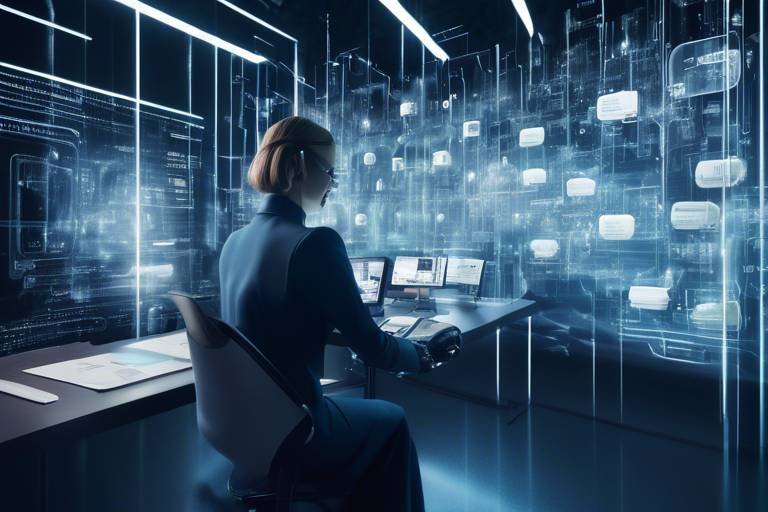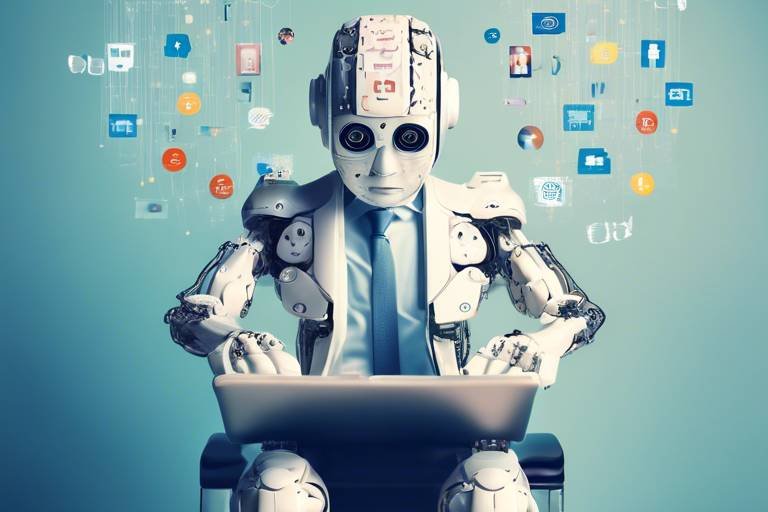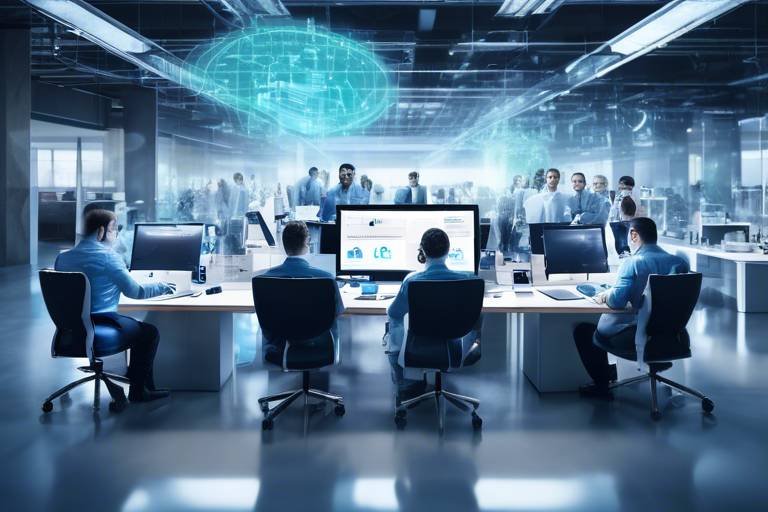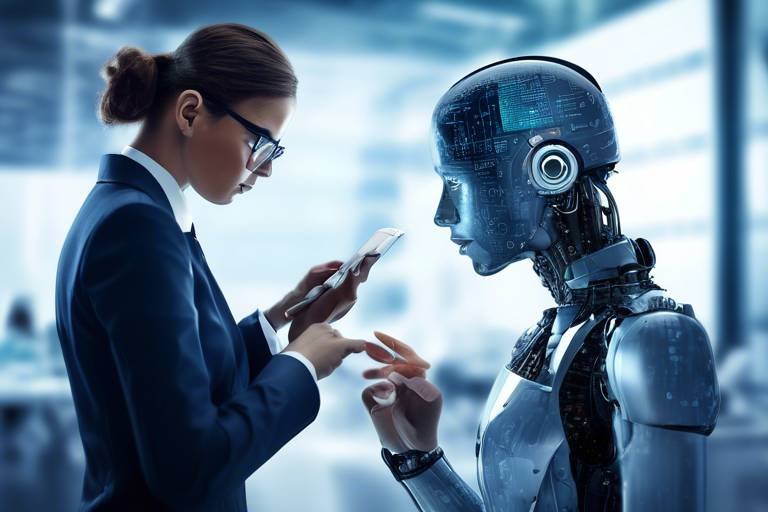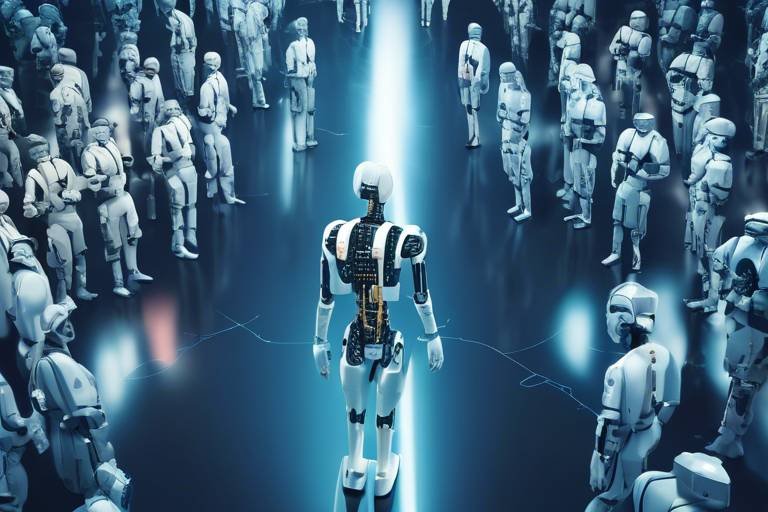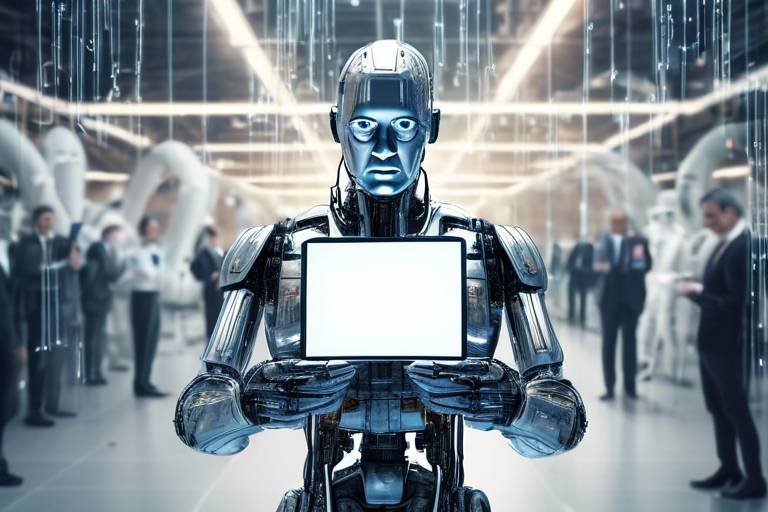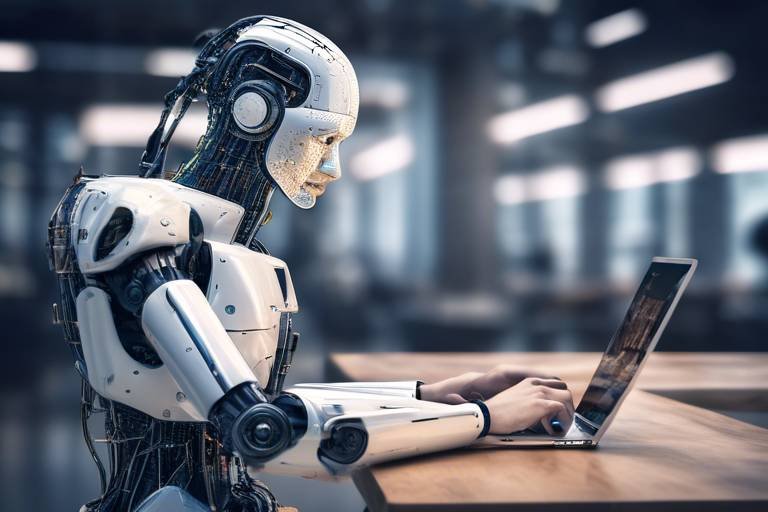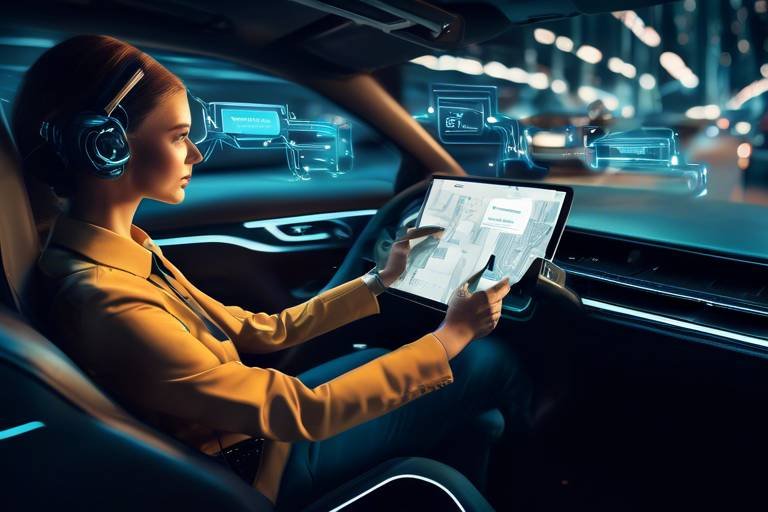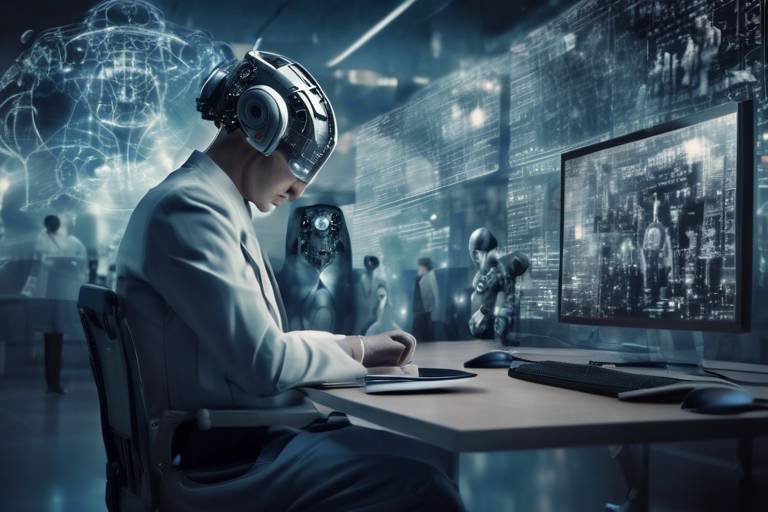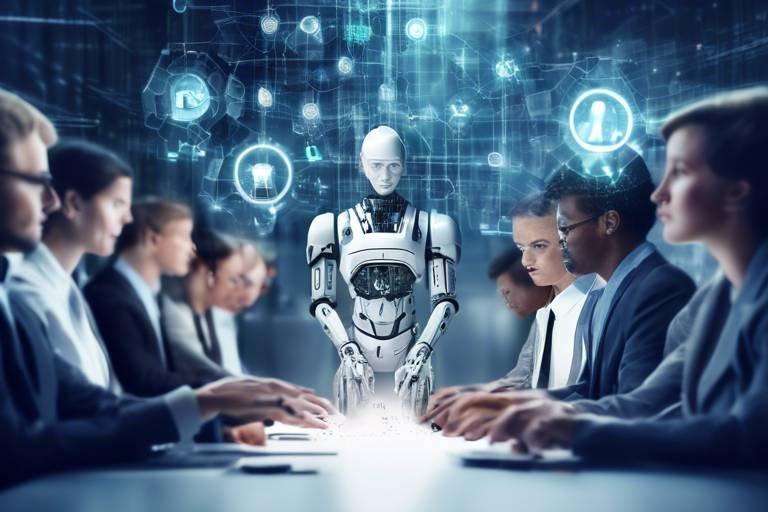The Audacity of AI: The Future of Work and Robots
In today's fast-paced world, the integration of Artificial Intelligence (AI) and robotics into our workplaces is not just a trend; it's a revolution. Imagine a landscape where machines not only assist us but also enhance our capabilities. This transformation is akin to the industrial revolutions of the past, but with a twist—this time, it's not just about machines replacing manual labor but about reshaping the very fabric of our work lives. As we delve into this exciting yet daunting journey, we’ll explore how AI and robotics are redefining the workforce, the opportunities they present, and the challenges we must navigate together.
While some may view AI as a threat to traditional jobs, it's crucial to recognize the potential for innovation and creativity that this technology brings. Think of AI as a powerful tool, much like the internet was in the late 90s. It opens up new avenues for collaboration, efficiency, and even entirely new industries. However, with great power comes great responsibility. We must consider how to harness this technology ethically and effectively to ensure a future where humans and machines coexist harmoniously.
As we embark on this exploration, we'll touch on various aspects, from the types of jobs most affected by automation to the essential skills workers will need to thrive in this new environment. We'll also discuss the importance of upskilling and reskilling initiatives, the role of human creativity, and the ethical implications of AI in the workplace. So, buckle up as we navigate the audacious journey of AI and its transformative effect on the future of work!
Automation is not just a buzzword; it's a powerful force reshaping industries across the globe. From manufacturing to healthcare, businesses are leveraging AI and robotics to enhance efficiency and productivity. But what does this mean for the workforce? In many sectors, routine tasks are being taken over by machines equipped with advanced algorithms and learning capabilities. For instance, consider the manufacturing industry, where robots can assemble products faster and more accurately than humans. This shift is not just about replacing jobs; it’s about redefining them.
According to recent studies, sectors such as transportation, retail, and customer service are among the most affected by automation. Here’s a quick breakdown:
| Sector | Impact of Automation |
|---|---|
| Manufacturing | Increased efficiency and reduced labor costs |
| Transportation | Rise of autonomous vehicles, reducing the need for drivers |
| Retail | Automation of checkout processes and inventory management |
| Customer Service | Chatbots and AI-driven support systems enhancing customer interactions |
As we can see, while automation offers immense potential for growth, it also poses significant challenges, especially in terms of job displacement. How do we strike a balance between leveraging technology and ensuring that workers are not left behind?
The increasing prevalence of AI and robots in the workplace is undoubtedly reshaping the job market. On one hand, we face the reality of potential job displacement, particularly for roles that involve repetitive tasks. On the other hand, new roles are emerging that require a different set of skills—ones that are more aligned with creativity, problem-solving, and emotional intelligence.
For instance, while a factory worker may find their role automated, there’s a growing demand for specialists who can manage and maintain these robotic systems. This shift calls for a proactive approach to workforce development. It’s not enough to simply react to changes; we must anticipate them and prepare accordingly.
To thrive in this evolving landscape, workers need to embrace lifelong learning. Upskilling and reskilling initiatives are becoming essential for adapting to new technologies and roles. It’s like having a toolbox filled with various tools—each one designed to tackle different challenges. In the world of work, these tools are the skills we acquire over time.
Effective training programs are critical in preparing the workforce for future demands. Companies are increasingly investing in training initiatives that not only focus on technical skills but also on soft skills, which are equally important in a technology-driven world. For example, programs that teach employees how to work alongside AI can significantly enhance employee performance and job satisfaction.
Collaborations between educational institutions and businesses can further enhance training effectiveness. By working together, they can create relevant curricula that equip students with the skills needed in the workforce. Successful partnerships have shown promising outcomes, leading to a more competent and adaptable workforce.
As we embrace the integration of AI, ethical concerns regarding bias and fairness come to the forefront. The deployment of AI systems must be guided by ethical principles to ensure that they do not perpetuate existing inequalities. It’s crucial to establish ethical guidelines that govern AI usage in the workplace, fostering a culture of transparency and accountability.
Despite the remarkable advancements in AI, one thing remains clear: human creativity is irreplaceable. AI can analyze data and generate insights, but it cannot replicate the human spirit of innovation. This is where the magic happens—when technology and creativity converge to create something truly remarkable.
AI can enhance teamwork by facilitating collaboration. With AI tools supporting creative processes, teams can brainstorm, innovate, and execute ideas more effectively. Imagine a workplace where AI assists in generating ideas, allowing humans to focus on what they do best—thinking outside the box and pushing boundaries.
Anticipating future job trends is crucial for workforce planning. As AI continues to evolve, emerging roles will demand new skills. Positions in AI ethics, data analysis, and human-AI collaboration are just a few examples of the opportunities that lie ahead. Staying ahead of the curve is essential for both individuals and organizations.
- What jobs are most at risk due to automation? Jobs that involve repetitive tasks, such as assembly line work and data entry, are most at risk.
- How can workers prepare for the future job market? Embracing lifelong learning through upskilling and reskilling initiatives is key.
- What is the role of ethics in AI? Ethics in AI focuses on ensuring fairness, transparency, and accountability in AI systems.
- Will AI replace all human jobs? While some jobs may be automated, many new roles will emerge that require human creativity and emotional intelligence.

The Rise of Automation
Automation is not just a buzzword; it’s a revolution that’s sweeping across industries like a wildfire. Imagine walking into a factory where robots are tirelessly assembling products while humans focus on creative problem-solving. This is the new reality that automation brings, enhancing efficiency and productivity at an unprecedented rate. From manufacturing to healthcare, automation is reshaping the way we work, allowing us to achieve more in less time. But what exactly does this mean for jobs and industries?
First off, let’s take a closer look at the types of jobs most affected by automation. Positions that involve repetitive tasks, such as assembly line work or data entry, are at the highest risk of being replaced by machines. According to a recent study, around 60% of jobs in sectors like manufacturing and logistics could be automated within the next two decades. However, it’s not all doom and gloom; while some jobs may vanish, new opportunities are emerging in areas that require human oversight and creativity.
Interestingly, sectors embracing automation are seeing significant transformations. For instance, the healthcare industry is increasingly utilizing AI for diagnostics, treatment planning, and even robotic surgeries. This not only speeds up processes but also enhances the accuracy of medical interventions. Similarly, the retail sector is adopting automation through self-checkout systems and AI-driven inventory management, allowing staff to focus on customer service rather than mundane tasks.
However, the rise of automation does come with its challenges. As machines take over routine tasks, there’s a growing concern about job displacement. Workers in vulnerable positions may find themselves struggling to adapt to this new landscape. To illustrate, consider a factory worker who has spent years mastering a specific skill set. With automation stepping in, this worker might feel like a ship lost at sea without a compass. But fear not, because with change comes the opportunity for upskilling and reskilling.
In summary, the rise of automation is a double-edged sword. It promises increased productivity and efficiency, yet it also poses challenges for the workforce. As we navigate this new era, it’s crucial for both workers and employers to embrace change and explore the possibilities that automation brings. After all, the future of work is not just about robots taking over; it’s about humans and machines collaborating to create a better workplace.
As we delve deeper into this topic, you'll discover how upskilling, reskilling, and ethical considerations play pivotal roles in shaping the future of work. So, buckle up and get ready for an exciting journey into the world of automation!
- What industries are most affected by automation? Industries such as manufacturing, retail, and healthcare are experiencing significant changes due to automation.
- Will automation lead to job loss? Yes, some jobs may be displaced, but new roles will emerge that require different skill sets.
- How can workers adapt to automation? Embracing lifelong learning and participating in upskilling and reskilling programs are essential for adaptation.
- What is the role of AI in automation? AI enhances the capabilities of automation by making processes smarter and more efficient.

The Impact on Employment
The rise of artificial intelligence (AI) and robotics is creating a seismic shift in the job market, akin to a powerful wave crashing on the shore, reshaping the landscape of employment as we know it. As machines become more capable and intelligent, they are not just augmenting human work; they are also taking on roles traditionally held by people. This transformation brings both opportunities and challenges, and it's essential to understand how these changes will affect the workforce.
One of the most pressing concerns is the potential for job displacement. Many sectors are experiencing significant changes, particularly those that rely heavily on repetitive tasks or data processing. For example, jobs in manufacturing, customer service, and even some areas of healthcare are being automated. According to a recent study, it is estimated that up to 30% of jobs could be at risk of automation by the early 2030s. This statistic is not just a number; it represents millions of workers who may find themselves needing to transition to new roles.
However, it's not all doom and gloom. While some positions may vanish, others will emerge, creating a new job landscape. The demand for roles that require human skills—such as creativity, emotional intelligence, and complex problem-solving—will likely increase. For instance, jobs in AI development, data analysis, and digital marketing are on the rise, reflecting a shift towards more strategic and creative roles. In fact, industries like tech, healthcare, and renewable energy are projected to see substantial growth in job opportunities.
To illustrate this shift, consider the following table that outlines some of the roles likely to be affected by AI and robotics, along with potential new job opportunities:
| Job Category | Potentially Displaced Roles | Emerging Roles |
|---|---|---|
| Manufacturing | Assembly line worker | Robotics technician |
| Customer Service | Call center operator | Customer experience designer |
| Healthcare | Radiologist | Health data analyst |
| Finance | Bank teller | Financial analyst |
As we navigate this evolving landscape, it's crucial for workers to remain adaptable. The ability to pivot and acquire new skills will be vital in securing employment in this brave new world. In fact, many experts believe that lifelong learning will become a cornerstone of career development. Workers must embrace the idea that education doesn't stop after formal schooling; it’s a continuous journey that will help them stay relevant.
In summary, the impact of AI and robotics on employment is profound and multifaceted. While the specter of job displacement looms large, the creation of new roles presents a silver lining. The key lies in adaptability and a commitment to ongoing education. As we stand on the brink of this transformation, the question remains: Are we ready to embrace the future of work?
- Will AI really take away my job? - While some jobs may be automated, new roles that require uniquely human skills will also emerge.
- What can I do to prepare for the future job market? - Focus on upskilling and reskilling yourself in areas that complement AI technologies.
- How can companies support their employees during this transition? - By investing in training programs and fostering a culture of continuous learning.

In today's fast-paced world, the need for upskilling and reskilling has never been more critical. As AI and automation continue to transform industries, workers must adapt to a rapidly changing job landscape. Think of it as a game of chess; just as players must anticipate their opponent's moves and adjust their strategies, employees must be proactive in learning new skills to stay relevant. The reality is, many traditional roles are evolving or disappearing altogether, which means that clinging to outdated skills is no longer an option.
This shift creates a unique opportunity for individuals to embrace lifelong learning. It’s not just about learning to code or mastering the latest software; it’s about developing a mindset geared towards continuous improvement. Companies are increasingly recognizing the importance of cultivating a workforce that can pivot and innovate. In fact, a survey by the World Economic Forum highlighted that by 2025, 85 million jobs may be displaced due to automation, but 97 million new roles could emerge that are more adapted to the new division of labor between humans, machines, and algorithms.
To illustrate the importance of upskilling and reskilling, let’s take a closer look at the types of skills that are becoming essential:
| Skill Type | Description | Examples |
|---|---|---|
| Technical Skills | Skills related to technology and digital tools. | Data analysis, programming, cybersecurity |
| Soft Skills | Interpersonal skills that enhance collaboration and communication. | Emotional intelligence, adaptability, critical thinking |
| Creative Skills | Skills that foster innovation and problem-solving. | Design thinking, content creation, strategic planning |
Organizations are stepping up to the plate by offering various training programs aimed at equipping their employees with the necessary tools to thrive. These initiatives not only enhance the skill set of the workforce but also improve job satisfaction and employee retention. After all, who doesn’t want to feel like they’re growing in their career? The key is for companies to foster a culture of learning where employees feel encouraged to pursue new knowledge and skills without the fear of failure.
Moreover, the collaboration between educational institutions and businesses is becoming increasingly vital. Partnerships can lead to tailored training programs that meet the specific needs of industries. These collaborations can also ensure that the skills being taught are relevant and up-to-date, bridging the gap between education and employment. By working together, businesses and educational institutions can create a more skilled workforce ready to tackle the challenges of tomorrow.
In conclusion, the landscape of work is changing, and with that comes the necessity for upskilling and reskilling. It’s not just a buzzword; it’s a lifeline for workers navigating the complexities of modern employment. By investing in their own growth and embracing the changes brought about by technology, individuals can ensure they remain valuable assets in their fields. So, are you ready to take the leap into lifelong learning?
- What is the difference between upskilling and reskilling?
Upskilling refers to enhancing existing skills, while reskilling involves learning new skills for a different job or role.
- Why is upskilling important in today's job market?
As technology evolves, many roles are changing or disappearing. Upskilling helps workers remain competitive and adaptable.
- How can I find upskilling opportunities?
Look for online courses, workshops, and training programs offered by your employer or educational institutions.

Training Programs
In a world where technology evolves at lightning speed, the importance of effective training programs cannot be overstated. These programs serve as the backbone of workforce development, ensuring that employees are not just surviving but thriving in an increasingly automated environment. Companies are recognizing that investing in their workforce is akin to planting seeds for future growth. Just as a gardener nurtures plants to yield a fruitful harvest, organizations must cultivate their employees' skills to adapt to the demands of modern work.
One of the most compelling aspects of training programs is their ability to bridge the gap between traditional skills and the new competencies required by emerging technologies. For instance, many industries are now focusing on data analysis, machine learning, and digital marketing. These fields are not just buzzwords; they represent a significant shift in how businesses operate. Therefore, training programs must be tailored to equip employees with the necessary skills to navigate this landscape. A well-structured program can include various components:
- Hands-on Workshops: Practical sessions where employees can apply what they've learned.
- Online Courses: Flexible learning options that allow employees to study at their own pace.
- Mentorship Opportunities: Pairing less experienced workers with seasoned professionals for guidance.
Moreover, the effectiveness of these training programs is often measured by their impact on employee performance and satisfaction. Companies that implement robust training initiatives often see a marked improvement in productivity and a reduction in turnover rates. A recent study revealed that organizations investing in employee training experienced a 24% increase in productivity and a 30% decrease in employee turnover. This statistic underscores the profound impact that effective training can have on both the individual and the organization as a whole.
To illustrate the benefits of training programs, consider the case of a tech company that implemented a comprehensive upskilling initiative for its staff. By introducing a series of workshops focused on artificial intelligence and machine learning, the company not only enhanced its employees' skill sets but also improved overall job satisfaction. Employees reported feeling more valued and empowered, leading to a more engaged workforce. This example highlights the importance of aligning training programs with both employee aspirations and organizational goals.
In conclusion, as we navigate the complexities of a rapidly changing job market, the role of training programs becomes increasingly critical. They are not merely an expense; they are an investment in the future of work. By preparing employees for the challenges ahead, companies can foster a culture of continuous learning and innovation, ensuring they remain competitive in a world where AI and automation are reshaping the landscape of employment.

Industry Partnerships
The rapidly evolving landscape of technology and automation necessitates a collaborative approach between educational institutions and businesses. This synergy is not just a trend; it's a critical strategy for ensuring that the workforce is equipped with the skills needed to thrive in an AI-driven economy. By fostering , we can create a robust framework for training that aligns with real-world demands. These collaborations can take many forms, from internship programs to co-developed curricula that reflect the latest industry standards.
For instance, consider a partnership between a local university and a tech company. The university can offer specialized courses in AI and machine learning, while the tech company provides insights into the skills they prioritize when hiring. This not only helps students gain relevant knowledge but also allows companies to shape the future workforce according to their needs. Such partnerships can lead to a more dynamic learning environment, where students engage in hands-on projects that mirror actual workplace challenges.
Moreover, these collaborations can significantly enhance the effectiveness of training programs. When businesses are involved in the educational process, they can offer mentorship opportunities, guest lectures, and even access to state-of-the-art technology. This kind of engagement helps students understand the practical applications of their studies and prepares them for the realities of the job market. In return, companies benefit from a more skilled labor pool that can hit the ground running.
To illustrate the impact of industry partnerships, let’s look at a few successful examples:
| Partnership | Industry | Outcome |
|---|---|---|
| University of California & Google | Technology | Development of AI curriculum and internship programs |
| Georgia Tech & AT&T | Telecommunications | Hands-on projects in 5G technology |
| MIT & IBM | Artificial Intelligence | Research initiatives and workforce training |
These examples show that when educational institutions and businesses come together, they can create a win-win situation. Students gain valuable experience and knowledge, while companies get access to a fresh pool of talent that is ready to tackle the challenges of the future. However, it’s important to ensure that these partnerships are built on mutual respect and a shared vision for the future of work.
In conclusion, as we navigate the complexities of an AI-driven world, the role of industry partnerships cannot be overstated. They are essential for creating a workforce that is not only skilled but also adaptable to the changes that lie ahead. By investing in these collaborations, we can pave the way for a brighter future where both individuals and organizations thrive.
- What are industry partnerships? Industry partnerships refer to collaborations between educational institutions and businesses aimed at enhancing workforce training and development.
- How do industry partnerships benefit students? Students gain access to real-world experiences, mentorship, and skills that align with current job market demands.
- Can industry partnerships help reduce unemployment? Yes, by equipping students with relevant skills, these partnerships can help bridge the gap between education and employment.

AI Ethics in the Workplace
The rapid integration of Artificial Intelligence (AI) into the workplace has brought about a transformative wave, but it also raises significant ethical concerns that we cannot afford to overlook. As businesses increasingly rely on AI to make decisions, manage workflows, and even interact with customers, the question of bias and fairness becomes paramount. How do we ensure that these intelligent systems operate without perpetuating existing inequalities or creating new ones? This is where the discussion of AI ethics comes into play.
One of the primary concerns is the potential for algorithmic bias. AI systems learn from historical data, which often reflects societal biases. For instance, if a hiring algorithm is trained on past hiring data that favored certain demographics, it may inadvertently discriminate against qualified candidates from underrepresented groups. This could lead to a lack of diversity in the workplace and reinforce existing stereotypes. To combat this, organizations must prioritize the development of algorithms that are transparent and regularly audited for bias.
Furthermore, the issue of accountability arises when AI systems make decisions that impact employees and customers. Who is responsible if an AI-driven decision leads to negative outcomes? Is it the developer, the organization, or the AI itself? Establishing clear guidelines and accountability measures is crucial for building trust in AI systems. Companies should implement frameworks that outline how decisions are made and provide channels for employees to voice concerns.
Another ethical consideration is privacy. As AI systems gather and analyze vast amounts of data, the risk of infringing on individual privacy rights increases. Employees may feel uncomfortable knowing that their performance and behaviors are constantly monitored by AI tools. To address this, organizations should be transparent about the data they collect, how it is used, and ensure that employees have control over their personal information. Creating a culture of trust is essential for fostering a healthy workplace environment.
To tackle these ethical dilemmas head-on, companies can adopt several strategies:
- Develop Ethical Guidelines: Establish a set of ethical principles that govern AI development and deployment.
- Conduct Regular Audits: Regularly assess AI systems for bias and fairness to ensure they align with ethical standards.
- Engage in Stakeholder Dialogue: Involve employees, customers, and other stakeholders in discussions about AI ethics.
- Invest in Training: Provide training for employees on the ethical implications of AI and how to use these tools responsibly.
Ultimately, the goal is to create a workplace where AI enhances human capabilities rather than diminishes them. By prioritizing ethical considerations in AI deployment, organizations can not only mitigate risks but also foster innovation and creativity. As we navigate this new frontier, it is essential to remember that while machines may be intelligent, it is the human touch that drives ethical decision-making.
1. What is AI ethics?
AI ethics refers to the moral implications and responsibilities associated with the use of artificial intelligence technologies. It encompasses issues like bias, accountability, and privacy.
2. Why is AI ethics important in the workplace?
AI ethics is crucial in the workplace to ensure that AI systems do not perpetuate discrimination, protect employee privacy, and establish accountability for decisions made by AI.
3. How can companies ensure ethical AI practices?
Companies can ensure ethical AI practices by developing clear guidelines, conducting regular audits, engaging stakeholders, and investing in employee training on AI ethics.

The Role of Human Creativity
In a world increasingly dominated by artificial intelligence and automation, one might wonder: can machines truly replicate the spark of human creativity? The answer is a resounding no! While AI can analyze data, generate patterns, and even compose music, it lacks the emotional depth and imaginative flair that humans bring to the table. Think of it like a painting; a machine can mimic brush strokes, but it can't feel the passion behind the colors. This is where human creativity shines and holds its ground.
As we dive deeper into the intersection of technology and creativity, it's essential to recognize that rather than replacing human ingenuity, AI can serve as a powerful ally. For instance, consider how artists, writers, and innovators can use AI tools to enhance their creative processes. These tools can help brainstorm ideas, generate content drafts, or even suggest design elements, allowing creators to focus on what they do best: dreaming up new possibilities.
Moreover, the collaboration between AI and human creativity can lead to unprecedented innovations. Just as the invention of the camera didn't spell the end for painting, AI won't eliminate creative professions. Instead, it opens up new avenues for exploration. For example, in fields like advertising and product design, teams can leverage AI to analyze consumer trends and preferences, ultimately leading to more targeted and effective campaigns. The synergy between human intuition and AI's analytical prowess can create a dynamic duo that drives success.
Interestingly, the future of work is not just about adapting to new technologies; it's also about fostering environments that celebrate creativity. Companies that prioritize collaborative workspaces and encourage brainstorming sessions are likely to see a surge in innovation. When teams come together, sharing diverse perspectives and ideas, the potential for breakthrough solutions skyrockets. AI can facilitate this collaboration by providing tools that help manage projects, track progress, and streamline communication.
As we look ahead, it's crucial to understand that creativity will remain a highly sought-after skill in the job market. Jobs that emphasize creative problem-solving, design thinking, and innovative strategy will be in high demand. In fact, a recent survey indicated that employers are increasingly valuing creativity as a key competency, with many believing it will be one of the top skills needed in the next decade. This highlights the importance of nurturing creative talent in educational systems and workplaces alike.
In conclusion, while AI continues to evolve and reshape industries, the role of human creativity remains irreplaceable. By embracing technology as a partner rather than a competitor, we can unleash a wave of innovation that not only enhances our work but also enriches our lives. So, the next time you hear about robots taking over jobs, remember that the human touch—the creativity, the passion, the imagination—will always be in demand.
- Can AI replace human creativity? No, AI can assist in the creative process, but it cannot replicate the emotional and imaginative aspects of human creativity.
- How can AI enhance creativity? AI tools can help generate ideas, analyze trends, and provide insights, allowing humans to focus on the creative aspects of their work.
- What skills will be in demand in the future job market? Skills such as creative problem-solving, design thinking, and innovative strategy will be highly sought after as AI continues to evolve.

Collaborative Work Environments
In today's fast-paced world, the notion of a collaborative work environment is becoming increasingly vital, especially with the rise of AI technologies. Imagine a workplace where humans and machines work side by side, each bringing their unique strengths to the table. This synergy not only enhances productivity but also fosters a culture of innovation. AI tools are designed to facilitate communication and streamline workflows, making collaboration smoother than ever before. For instance, platforms powered by AI can analyze team dynamics and suggest optimal ways to organize tasks, ensuring that everyone is on the same page.
Moreover, the integration of AI in collaborative settings can lead to a more inclusive atmosphere. By utilizing AI-driven tools that cater to diverse communication styles and preferences, teams can bridge gaps that might have previously hindered collaboration. This means that whether you're a visual learner or someone who thrives on verbal communication, there's a tool tailored for you. It's like having a personalized assistant that understands your needs and helps you connect with your teammates more effectively.
However, the human element remains irreplaceable. While AI can manage data and optimize processes, it lacks the emotional intelligence that humans bring to teamwork. This is where the magic happens—when human creativity meets AI efficiency. For example, brainstorming sessions can be enhanced by AI tools that provide real-time data analysis, helping teams make informed decisions on the fly. These tools can sift through vast amounts of information, presenting insights that can spark innovative ideas and solutions.
Additionally, collaborative work environments foster a sense of community. When teams collaborate effectively, they build trust and camaraderie, which are essential for long-term success. The role of AI in this context is to support these relationships rather than replace them. By automating mundane tasks, AI allows team members to focus on what truly matters—building relationships and creating value together.
To illustrate the impact of AI on collaboration, consider the following table that highlights key benefits:
| Benefit | Description |
|---|---|
| Enhanced Communication | AI tools facilitate seamless communication across teams, breaking down silos. |
| Data-Driven Insights | AI analyzes trends and patterns, providing teams with actionable insights for decision-making. |
| Increased Efficiency | Automation of repetitive tasks allows teams to focus on higher-value work. |
| Personalized Collaboration | AI adapts to individual team members' styles, enhancing overall team dynamics. |
Ultimately, the future of work is not about replacing humans with machines; it's about creating a harmonious blend of both. As we embrace this new era, fostering collaborative work environments enriched by AI will be key to unlocking creativity and driving innovation. So, are we ready to harness the power of AI while celebrating our unique human capabilities? The answer lies in how we choose to adapt and collaborate in this rapidly changing landscape.
- What is a collaborative work environment?
A collaborative work environment is a workspace where team members work together towards common goals, leveraging each other's strengths and skills. - How does AI enhance collaboration?
AI enhances collaboration by streamlining communication, providing data-driven insights, and automating repetitive tasks, allowing teams to focus on creative problem-solving. - Can AI replace human creativity?
No, AI cannot replace human creativity; rather, it complements it by providing tools and insights that can inspire innovative thinking. - What skills are important for working in a collaborative environment?
Key skills include effective communication, adaptability, emotional intelligence, and the ability to leverage technology for teamwork.

Future Job Trends
The workplace is evolving at a breakneck pace, driven by the relentless march of technology. As we look ahead, it's evident that the landscape of employment will undergo profound changes. The question on everyone’s mind is: what will the future job market look like? In a world where artificial intelligence and automation are becoming the norm, several trends are emerging that will shape the jobs of tomorrow.
One significant trend is the rise of hybrid roles that combine traditional skills with technological expertise. For instance, consider the role of a data analyst. In the past, this position primarily focused on interpreting data and generating reports. However, as AI tools become more sophisticated, data analysts must now also understand machine learning algorithms and data visualization software. This blending of skills is crucial for staying relevant in an increasingly automated world.
Moreover, the demand for soft skills is skyrocketing. While technical skills are undeniably important, human qualities such as creativity, emotional intelligence, and critical thinking are becoming essential differentiators. Employers are recognizing that while machines can process data and perform tasks, they lack the human touch that drives innovation and fosters teamwork. For example, roles in customer experience management will require professionals who can empathize with customers and provide personalized solutions, a task that AI alone cannot accomplish.
Another trend to watch is the growth of the gig economy. More individuals are opting for freelance work or short-term contracts instead of traditional full-time positions. This shift is largely due to the flexibility that gig work offers, allowing people to pursue multiple interests and projects simultaneously. Companies are also benefiting from this trend by accessing a broader talent pool without the commitment of permanent hires. According to recent statistics, it’s projected that by 2025, over 50% of the workforce will be engaged in some form of gig work.
To further illustrate these trends, let’s take a look at a table summarizing the anticipated job roles and skills that will be in demand:
| Job Role | Key Skills Required |
|---|---|
| Data Analyst | Machine Learning, Data Visualization, Statistical Analysis |
| Customer Experience Manager | Emotional Intelligence, Communication, Problem-Solving |
| Digital Marketing Specialist | SEO, Content Creation, Social Media Management |
| Cybersecurity Expert | Risk Assessment, Network Security, Incident Response |
| AI Ethicist | Ethical Decision-Making, Policy Development, Critical Thinking |
As we navigate this changing landscape, it’s crucial for both individuals and organizations to remain proactive. Workers should continuously seek out opportunities for upskilling and reskilling to adapt to new technologies and market demands. Organizations, on the other hand, must foster a culture of lifelong learning and provide resources for employees to grow their skill sets. The future of work is not just about surviving the changes but thriving in them.
In conclusion, the future job market is poised for transformation, driven by technology and the evolving needs of society. By embracing change and focusing on the skills that matter, both workers and employers can position themselves for success in this exciting new world. The future is bright, but it requires a commitment to adaptation and creativity!
- What skills will be most important in the future job market?
Skills such as data analysis, emotional intelligence, and adaptability will be crucial. - How can I prepare for the changes in the job market?
Consider enrolling in upskilling programs, attending workshops, and seeking mentorship opportunities. - What is the gig economy?
The gig economy refers to a labor market characterized by short-term contracts or freelance work instead of permanent jobs. - Will AI take away jobs?
While some jobs may be displaced, new roles will emerge that focus on human-centric skills and creativity.
Frequently Asked Questions
- What is the impact of AI on the job market?
The impact of AI on the job market is profound and multifaceted. While automation may displace certain jobs, it also creates new opportunities in emerging fields. For instance, roles in AI development, data analysis, and tech support are on the rise. It's a bit like a game of musical chairs—some people may lose their seats, but new ones are added as the game progresses.
- Which industries are most affected by automation?
Industries such as manufacturing, retail, and transportation are seeing significant changes due to automation. Robotics and AI are streamlining processes, improving efficiency, and reducing costs. Think of it as a factory floor where robots are taking over repetitive tasks, allowing human workers to focus on more complex and creative challenges.
- How can workers prepare for changes in the workforce?
Workers can prepare for changes in the workforce by embracing lifelong learning. Upskilling and reskilling are essential to stay relevant in this evolving landscape. It's like updating your smartphone—if you don't keep up with the latest software, you might miss out on new features and functionalities!
- What role do training programs play in adapting to AI?
Training programs are crucial for equipping the workforce with the skills needed for the future. They help employees understand new technologies and how to work alongside AI. Successful initiatives can significantly enhance employee performance and job satisfaction, much like a well-designed workshop that transforms a novice into a pro.
- How do industry partnerships enhance training effectiveness?
Collaborations between educational institutions and businesses can create tailored training programs that meet industry demands. These partnerships ensure that the skills being taught are relevant and up-to-date, similar to how a tailored suit fits better than an off-the-rack option.
- What ethical concerns arise with AI in the workplace?
Ethical concerns such as bias and fairness are critical when integrating AI into the workplace. It's essential to establish guidelines that ensure AI systems are designed and implemented responsibly. Think of it as setting the rules for a fair game—everyone should have a chance to play without unfair advantages.
- Can AI enhance human creativity?
Absolutely! AI can complement human creativity by providing tools that facilitate collaboration and innovation. It's like having a trusty sidekick—AI can handle the heavy lifting while humans focus on the creative aspects, leading to groundbreaking ideas and solutions.
- What future job trends should we be aware of?
As AI continues to evolve, emerging roles in fields like AI ethics, data science, and human-AI collaboration will be in high demand. Staying ahead of these trends is essential for workforce planning, much like keeping an eye on the horizon for approaching storms or opportunities.



